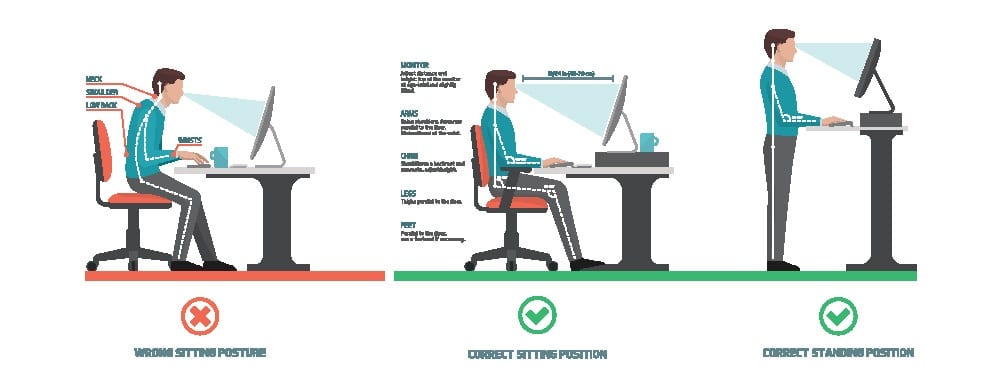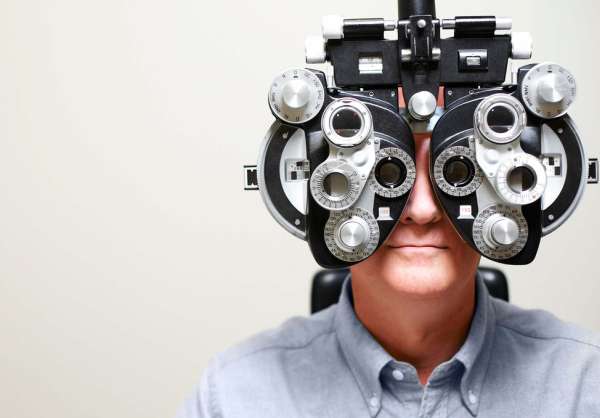If the above-mentioned measures do not relieve your eye symptoms then consultation with an eye surgeon is mandatory.

Various eye problems arising out of working on a computer for prolonged time are termed as “Computer Vision Syndrome” (CVS). It is essential for a computer professional to understand this syndrome, treat & prevent it if he has to continue working on a computer for many years to come.
A. Identify CVS related symptoms & understand how & why they appear.
B. Evaluate the work environment.
C. Decide whether eye examination by an expert is essential.
D. Treatment & prevention of CVS by changes in the Work environment and Body/Eyecare.
A human eye is covered with a thin layer of tear film at all times when open.This tear film protects the delicate cornea from external offenses & also makes an extremely smooth surface of the refracting lens of the eye(i.e cornea).Constant blinking of the eyelids replenishes the tear film.
Decrease in the tear secretion, increase in its rate of breaking down,decreased blinking & irregularity of the surface/s in contact with the tear film will all contribute to the instability of tear film & therefore dry eyes. These in the form will lead to irritation;stinging in eyes,eyestrain & increase in the frequency of infection of the eyelids. Working on the computer increases the demands of the eyes. Continuously staring at the screen along with decreased blinking (due to concentrating while working)makes the tear film unstable.Increased glare from the light reflected from the screen,abnormal body posture, inappropriate placement of the computer monitor contribute to the destabilization of the tear film. This leads to eyestrain & burning/stinging.This is CVS. If there are additional eye problems like uncorrected refractive error,disorders of the eyelids, etc they increase the severity of CVS.

The screen should be 20-28 inches away from your eyes. Ideally 24 inches. The monitor should be placed straight ahead in front of the person & not on the side. The midpoint of the monitor screen should be 4-5 inches below the eye level.
LCD screens are better than CTR for eyes. The flicker rate should be at or above 85 Hz. Normally it is set at 60 Hz. In some monitors, it is possible to alter the flicker rate. Color monitor- Better to have smaller dot pitches (<0.28mm). Working font size should be three times bigger than the smallest readable size. Contrast- White & black offer the best contrast. Never opt for black background. Better to have high contrast.
Reflections reduce the contrast & lead to strain. Generally, a source of light like electrical light or window should not be placed behind the PC monitor or behind the computer operator. A source of light should be placed on top, above the field of vision of the computer operator. An offending source of light should be identified & should be taken care of by removing it or placing blinds over it. An anti-reflection screen is seldom necessary & only in severe cases. Glass screen is better than mesh screen. However, the anti-reflection screen may cause a slight change in colors on monitor which may be a problem for some professionals.
Maintaining correct body posture is necessary to avoid CVS as well as orthopedic problems.
Neck: Should be straight up, not bent forward.
Head: Should be looking straight ahead, not turned to either side.
Back: Should be upright, properly supported by ergonomically designed chair & the person should be sitting right behind in chair sitting only on the front half of the seat causes back bending & lower backache.
Arm, forearm: Should not unduly be stretched.
Wrist: Should be floating in the air while working on keypad & resting on the wrist, rest when not in use. A sharp edge of the keyboard drawer often injuries wrist while typing, it is better to keep the hand and forearm in straight position & avoid an angle at wrists.
Thigh: The hip joint should be at a level slightly higher than knees.
Feet: Should be placed, resting fully on the ground or footrest. Remember the best working posture. Is the posture without strain.The ergonomically designed chair should have a Backward forward indication of the backrest. Adjustable lower backrest curvature. Adjustable seat height. Not too hard & not to soft seat of porous material. Adjustable headrest, handle, footrest.
1. Contact Lens:
Also, add to the dryness factor. In fact some of the several cases of dry eyes ar seen with the combination of AC+PC+CL (air conditioner + personal computer + contact lenses) CL user should take following measures-
a. Select soft lenses over semi-soft lenses.
b. Select lenses with higher oxygen permeability.
c. In the duration of CL users exceed 12-14hrs, it is better to remove CLs for one hour during lunch.
d. Maintain the CLs in good condition i.e daily cleaning, polishing, etc.
2. Computer Glasses:
Glasses required while working on a PC can be required in two circumstances.
a. A small or minor refractive error may become symptomatic while working on PC due to increase in demand from eyes. Otherwise, these errors do not cause discomfort.
b. After 40 yrs of age, one requires separate glasses for distance & near. The PC monitor at 60cm or 24inches is not seen clearly with either of there glasses. Then, one more pair of glasses for intermediate distance may be necessary. These intermediate glasses may be prescribed as multifocal/ progressive glasses or as bifocals where the upper glasses are for intermediate distance (viewing monitor) and the lower glasses are for near (viewing keyboard & reading material).
3. Two-wheeler driving without helmet adds to the severity of CVS.
If the above-mentioned measures do not relieve your eye symptoms then consultation with an eye surgeon is mandatory.

काॅंपुटर आणि मोबाइलचा वापर लाॅकडाउन मुळे वाढतच आहे. त्यामुळे डोळ्याना अपाय होऊ शकतो. डाॅ. चंद्रशेखर वावीकर, मेडिकल डायरेक्टर, वावीकर आय इन्स्टीट्यूट , या विषयात तद्न्य आहेत. ते अत्यंत सोप्या शब्दांत डोळ्यांची काळजी कशी घ्यायची हे विडीओ द्वारे समजावीत आहेत.